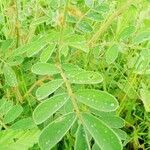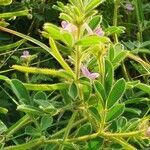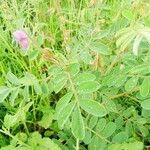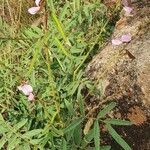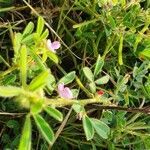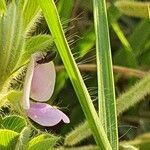Annual or briefly perennial bushy herb 0.3-1.3 m tall; stems tomentose. Leaf-rhachis up to 10 cm long, including a petiole of up to 10 mm., prolonged up to 7 mm beyond the lateral leaflets; stipules narrowly triangular, up to 8 mm long; leaflets 11-15, cuneate-oblong or elliptic, up to 35 x 12 mm., densely appressed villous beneath, more sparsely so above; main nerves about 9 on each side. Flowers purple in moderately dense terminal pseudoracemes and often also in upper leaf-axils; bracts narrowly triangular; pedicels densely tomentose, 2-4 mm long. Calyx densely tomentose, the hairs 1 mm or more long; tube up to ± 2 mm long; lobes long-acuminate, the lowest up to 8 mm or more long, upper pair up to ± 7 mm long, united for up to ± 2 mm. Standard densely fulvous tomentose outside, up to 11-15 mm long, including a claw of ± 2 mm., up to 9-10 mm wide; keel glabrous. Upper filament lightly attached, widened but not callous a little above the base; filament-sheath up to ± 6 mm., free parts up to 2-2.5 mm., anthers 0.5 mm long. Style glabrous, tapering, twisted, bent sharply upward at base, penicillate, up to 3-5 mm long. Pod strongly curved usually becoming deflexed so that the base is often parallel with the stem, bent sharply up near the tip, up to 5.4 cm long and up to 5-6 mm wide, densely silvery or fulvous tomentose, the hairs often up to 2 mm long. Seeds 6-12, muricate, longitudinal, oblong, ± 4 x 2.5 mm., distance between their centres under 5 mm.; hilum central, aril small and strap-shaped or none.
